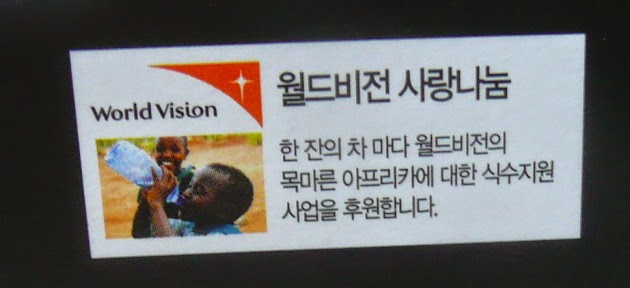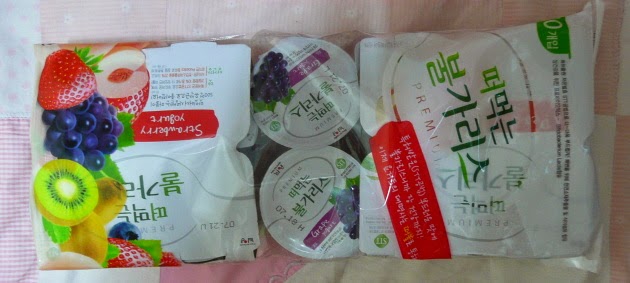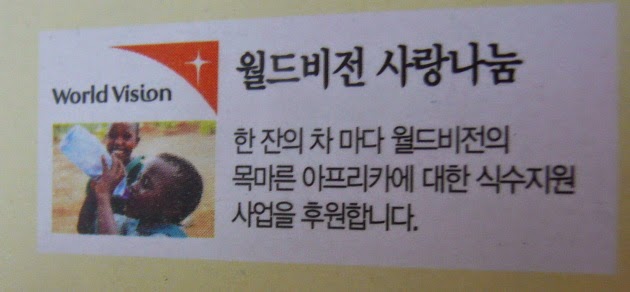Korea has roughly three types of common supermarkets. Hypermarket-size of big chains (Lotte, E-Mart, Home Plus), small stores of the same chains and then "off brand" supermarkets present in residential neighborhoods. Obviously, the selection is the largest in the first type of store, but not always it's the place where you'll get the best deal.
The important thing with big chains is that they monitor each other's prices and offers. If Lotte comes up with a 9-yogurt pack for 5000 Won, E-Mart will sell 10-packs for 4900 the next day. Usually. These promos are however also time-limited (often just a week or two) and last as long as the stock lasts, so my ultimate advice is buy multipacks when it seems like a good deal (considering the normal price of yogurts, both Lotte and E-Mart packs were a bargain) and don't worry if it could have been a couple hundred yen cheaper in the other chain or not.
On top of these multi-packs of items within the same category, these stores also have free gifts with almost everything. You will see it on the photos below, but you can very often get chocolade spread + jam for the same price as the chocolate spread alone.
Lotte (and rarely E-Mart) also have discounts on stuff near its expiry date - especially RTE meals - but these discounts rarely drop below 50% for processed foods and 70% for foods pre-packed on the spot and sometimes prices drop gradually - 20% off, in one hour 40% off, and later 70% off. They discount also pre-packed fruit and vegetables, but the price difference is laughable.
The small stores of these chains have usually pretty poor selection and are only worth checking out for RTE food that might be nest expiry - in Wangsimni area, Home Plus has quite an array of discounted food almost daily.
The indie supermarkets are great for looking for deals on particular products (often linked to nearing expiry date) and for finding cheaper brands.
Things I would never ever buy in a supermarket are fruits and vegetables, because you can get a gazillion times better price, quality and cultural experience in street markets and small vegetable shops; and side-dishes, because there are small stores run by ahjummas that have home-made style ones for a very good price (about 30% of the supermarket price per 100 g).
Here are some interesting products I've found as well as examples of promos and multi-packs. I'll try to estimate the price as well, though I don't remember that well.
Yogurt drink powder was one of the hot items this past summer. By mixing the powder provided with milk, you get a drink which is very similar in taste to yogurt, but of course without any of the benefits yogurts have due to their fermented nature, not to mention it contains heaps of sugar and artifical flavourings. You can also turn it into ice cream. Each box cost about 8000 Won, which is not particularly cheap, given the nutritional value. The left box is a good example of a promo - you get a free bottle inside the box and several extra sachets.
Here's an interesting brand I found in one of the indie supermarkets around Wangsimni - the packaging's really cute.
My very first grocery purchase in Korea - vitamin yogurt shots (suspiciously similar in design to Yakult) for some 2000 Won on promo (dirt cheap, and decide for yourself if the format decreases food waste because the product spoils slwer when packed in individual portions; or increases packaging waste compared to a 1 L bottle; or both). The E-Mart brand green tea, of course, is the cheapest option and works with both hot and cold water, which is a great thing during summer. Make it cold (by leaving the tea bag overnight in a bottle filled with cold water in the fridge) to take with you when going out, make it hot when freezing in office or lab air conditioned to -10 °C. Finally, Grape jam is a flavour I haven't seen much in Europe, and it's also the cheapest flavour available (around 3000 Won). I recommend you to try it, because Korean grapes taste very different from those you can usually buy in Europe. It tases nice and contains pieces of grapes (so you can assume the jam has seen some real fruit).
Mini Home Plus discounted food - Kimbap (yummy) and blueberry milk (a tad bit too sweet but nice).
Discounted Home Plus sandwich (western style) and the crisps Kellogs had just launched worldwide back then. They taste nice and sinc ethey were on promo for 3000 Won I decided to give them a try. I don't recall the calories, but nutritionally they're not really much better than potato crisps, possibly they contain less oil, but it's just starch.
This E-Mart capuccino range tastes absolutely awful and I recommend you to stay away from it, especially this tiramisu one. If you crave for other countries' groceries, E-Mart has a foreign-food shelf, so I got some miso soup - be aware that all non-Korean imported food is veyr very expensive though. Of course there are about 50+ different kinds of cup noodles for some 600 - 5000 Won per cup, I gotta admit I bought this one purely so that I could have a bowl to re-use (believing in Korean researchers proving that polystyren does ot release worrying amounts of substances). Lastly I bought the mint candy since I caught a cold, but they're not really minty and the size, shape and structure don't feel very nice in the mouth either.
Mini Home Plus again - discounted cup noodles and the famous banana milk (they have a whole range of flavors now). Roasted grain-based tea is a staple in Korean tea offering, below you can see corn tea. The price of these basic brands is roughly the same everywhere thanks to the price war between chains. Lastly these pouch drinks with attractive design were everywhere during summer, but in fact it's just sugary water sold for 4000+ Won - so not worth the money at all.
The cheapest gim (roasted seaweed) multipack I found in E-Mart - there are around 10 or more brands and promos all the time, so if you care about striking a deal it takes some calculations. I think each pack of these came to about 400 Won or so. My goshiwon served free food, but it was very repetitive - so I would sometimes "spice it up" by making rolls from the gim, rice and garlic stems as observed being done by my co-workers.
The Heladiv banana tea is absolutely delicious, dirt cheap (I think 2000 Won) and fair-trade. Then there is a rare instance of me buying a salad at E-Mart (but 1500 Won is an OK price), discounted salad dressing (the best catch ever I think, going down from almost 10 000 Won to 1500) and overpriced seaweed salad (nice taste though).
Fruit vinegar drinks were also very popular during summer. They come in a variety of flavors, have very few calories, are rich in some vitamins and other stuff (sorry ofr the incomplete info), give refreshins sour and fruity flavor to water and considering how much you put per 1 L of water, also a good valiue for money. For 10 000 Won, I bought a 900 ml bottle with another flavour in 500 ml size for free. Youcan also buy bigger bottles and multi packs, but that's hard to consume by one person alone.
Double pack of strawberry jam and chocolate spread from E-Mart for the price of just the chocolate spread - 4000 Won. The spread comes in varying pecentages of chocolate content, I chose the dark one. It has fewer calories than Nutella and tasted really nice.
Korea is really into healthy "shots"/drinks - I got this vitamin C drink from my unnie at work, because it has "vita" in it. Bottle is around 500 Won I think.
For Doraemon fans - Doraemon chocolate milk from Home Plus (and un-related band aid).
Home Plus discounted peanut sandwich in an extremely cute packaging.
Ok, now we're getting to the point when I started going to Korean lessons near the big Lotte Mart at Seoul Station. I got my favourite sweet tooth drink ever - green tea latte - on a promo with 5 extra sticks, but it's still expensive (7000 Won I think, but they support charities - see next photo) compared to normal green tea or making your own gren tea latte from scratch. When it comes to soft drinks, Aloe drink is my favourite (they sell the Korean one in many Vietnamese shops in Prague) and a big bottle is around 2000 Won. On the right there is a double pack of something between peach juice and smoothie with very artificial taste, but each bottle came to only 500 Won, which is a bargain, and the packaging is cute. Also, bonus points for grouping the bottles by tape instead of a plastic bag.
Yogurt multipacks I talked about in the intro - great deal on normally very expensive dairy (lactose-intolerant, do not rejoice - soy stuff is nowhere near cheap either) vs. tons of packaging waste.
Snacks - the buns are filed with something that should have been honey flavour I believe, and they tasted pretty yucky. I wasn't impressed with the ramen noodle snack either, but I recommend you to try it as it's very unique. It works just like ramen noodles, minus hot water - just breakdown the noodles, add powder, shake and eat as crisps.
The cheapest lunch possible - ahjosshi-style bento on sale before expiry (Seoul station Lotte has tons of these every night) and once again I got lured by the pretty looks (and discounted price) of the rice cakes, but I really really dislike how they taste. The only Korean rice cakes I like are artisanal ones in cafes and specialized shops, the supermarket ones to me taste like taste-less teeth-glueing matter.
I can't help it - I love cute snacks. However, this one is, just like many Korean products, guilty of packing air to make the product appear bigger. I used to frown upon Korean brands marketing their products as eco-friendly by not packing extra air, but in Korean context, that actually is a bold step since the majority of brands wants the biggest shelf exposure and image of containing a lot, which means way too much air inside and way too much packaging material.
In Korea, it's much easier to buy different kinds of sugar for a very reasonable price. This particular one tasted really nice. On the right, there is organic lavender tea. I needed these two ingredients to make lavender syrup.
Grain overdose - one great thing about Korea is the amount of puffed grain snacks. They have decent nutritional value and not too many calories. The "Super combo popcorn" (2000 Won for 180 g - that's a really good price, Lotte) is my favourite snack ever. And some more grain-based tea with a free mini box of another kind of tea.
Some Lotte discounted RTE foods - kimbap and salad - and promo multi-pack of the iconic flavoured milks - my favourite is the light version of the banana one, but strawberry is not bad either.
More tea - the doublepack was a really good deal on powder green tea (both for 5000 Won), but ontrary to my expectations, it tasted nothing like matcha. Below is persimmon leaf tea, my friend's favourite, but I'm not such a big fan. And buckwheat tea for less than 1000 Won.
More yogurt multi-packs.
Finally en example of a bargain found at one of the indie stores - this soft drink usually sells for more than 2000 Won at Lotte and the like but they had it for 1500. It has the flavouring and colouring agent sealed in the cap, and it is released when you twist it.
I think this one is from Lotte - double pack of yogurt drinks that were about to expire for 50% off of the price of one, great deal.
Both Japan and Korea are more of a 2 meals a day rather than 5 meals a day countries, so while I drink this meal-replacement nut tea as snacks in-between meals (Koreans use coffe for this purpose), they drink it instead of breakfast. It may take some time to get used to the idea of having pieces of things swimming in your drink, but the overall taste is quite good and nutrition is pretty good.
This is an IMPORTANT SNACK - TRADITIONAL KOREAN POPCORN. You see the cute puffing and shooting machine on the packaging? That is how it actually is popped - hence the characteristic shape of the kernels after puffing, which is very different from the western-style popcorn. It tastes a little sweet because of the products of chemical reactions that happen at the high temperature in carbohydrate - rich food, but no added sugar - I consider it the best weight loss/healthy eating snack if you have troiuble giving up things like crisps, sweet popcorn, candy and the like. You can get it both at the supermarket and in street markets.
Instant tteok (rice dumpling) soup. I haven't looked into it but it looks like it really is a product made by a small farm.
Coffee is omnipresent and extremely popular with (especially young) Koreans. Apart from western brands, there is a big brand called Maxim, making a range of instant coffee drinks. They're pretty afforable, but even more so when they go on promo, These boxes were around 2000 - 3000 Won instead of the usual 3000 - 4000.
Following photo features some RTH foods bought for my research (their packaging is horrible and I would love to meet the impractical people who designed it and ask them to use it), milk double pack (milk is so expensive in Korea - at least compared to the prices I'm used to in Europe - that I wouldn't have bought it even in this promo pack if I didn't need it for soothing pads for my irritated eyes) and snacks. Most of the sweet ones I bought to eat actually as cereals with the milk and I was pleasantly surprised by the number of whole-grain or vitamn and mineral-enriched options. Then the green box are potato crisps. All of these snacks cost around 800 - 1500 Won per bag/box.
There is even a DIY snack! I have a feeling I've seen a very similar one in Japan, so I wonder who stole the idea from whom, but nevertheless it's a cute thing - you get biscuits, milk chocolate and strawberry white chocolate and plastic mold, you pour the chocolates in the mold, stick the biscuit in and leave in the fridge for a couple of hours, and voila!
Popular brands of cooking pastes and sesame oil - I would say these are not worth bringing home from Korea because as long as you have an Asian grocery store with Korean food, they will have these for a pretty reasonable price.
The pink alcohol looks cute but tastes awful, so beware.
Kakao group's peach snack (not bad) and weird ice cream combo - the watermelon was really really off.
Melon milk - I'm starting to believe that whatever thing in Korea contains melon and dairy is better left alone.
Things I decided to bring from Korea to Europe:
Dried ginseng - fresh one is forbidden to export, good for soups and stews and steamed rice, possibly also for tea
Kelp - for soups and stews
Omija berries (dried) - E-Mart has two kinds that look almost the same, but one costs 20 000 Won and the other 5 000 Won - so make sure you get the right one. Great for tea and punch and very healthy and tasty.
Jujube (dried) - for tea, steamed rice, soups and stews
Anchovies - for soups, stews and side dishes - if you have more space, buy them for cheaper price in street markets in bulk, but small bags are only available at supermarkets.
Red bean jelly bars - my favourite snack ever, a tad bit healthier than western sweet snacks
Dried pollack - for certain soups or snacking
Chestnuts - for steamed rice or snacking, but very very expensive
Korean red pepepr flakes - absolutely neccessary for most Korean recipes and especially kimchi - I had only 200 g "space" in my luggage left so I had to go for a small pack of organic ones, but I would buy them in bulk, knowing how much you use all the time. However, may be available at local Korean or other Asian grocery stores.
Yours truly
Vita


















































Jééé, já bych si to všechno dala a hned! :3 Musím aspoň na Ebay na nějaké ty nákupy dobrot. :D
ReplyDelete